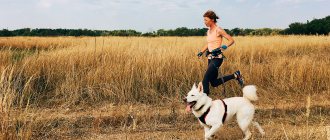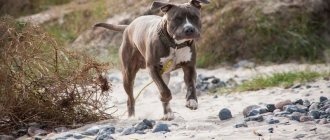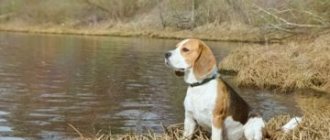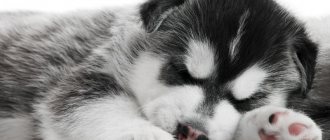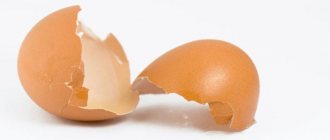The Siberian Husky is a breed designed for people who lead an active lifestyle. Dogs love to run long distances and happily take children and adults on sleds. Get a husky, and your life will certainly be filled with joy and fun chores.
Blue-eyed huskies have long been everyone's favorite. There are a huge number of pictures and videos on the Internet dedicated to the antics of these dogs. Many believe that huskies experience a “feeling of guilt” after their outrages. The dog has a corresponding “guilty” expression on its face.
Origin of the breed
The Siberian Husky is an ancient breed of dog that appeared in the Neolithic. The animals were bred by the indigenous peoples of the Russian Far East. In the 17th and 18th centuries, due to the active development of the eastern part of Russia, an increased demand for sled and working dogs arose. Russian travelers learned from local residents how to properly drive sleds and harness huskies to sleds. The number of animals has increased sharply.
At the beginning of the twentieth century, huskies were brought to the United States. Gold miners and prospectors in Alaska appreciated the strength, endurance and speed characteristics of the new breed. In 1934, the Husky received official recognition from the American Canine Associations. Animals began to be exported to the UK, France and other countries. Dogs have gained worldwide fame and become heroes of films and books. Animals returned to Russia after the collapse of the USSR.
Differences between Husky and Malamute
Siberian Huskies differ from Malamutes in their purpose. Malamutes were bred to transport heavy loads over short distances. This is a powerful animal that has an athletic build. Huskies and Malamutes have different appearances and personalities. The Malamute has a balanced temperament and strives to please its owner.
Purpose of the Siberian Husky breed
The Siberian Husky is a sled breed that was bred to transport light loads and people in harsh climatic conditions. Further development of the breed led to the emergence of sporting, hunting and decorative branches.
Sports dogs are regular participants in team racing. Show dogs amaze viewers with their unusual appearance and often take part in various shows. Many private breeders use Huskies as a companion.
Hunting with Husky
The dog has a highly developed hunter instinct. It easily catches up and kills small game. A pack of huskies will kill a wild boar, goat, pig or other medium-sized animal without any problems. Using a dog in the hunting process is associated with certain problems. Husky does not consider it necessary to bring killed prey to its owner. The process of teaching a dog this action can take a long time. There are kennels that breed a special line of huskies designed exclusively for hunting. Such a dog will become a faithful assistant to the huntsman.
Photo gallery
In the photographs that we have selected for you, you will see the beauty and grace of a representative of this breed. With the right approach to the dog, you will get an excellent hunting companion.
Character of the breed
The Siberian Husky is distinguished by its independent character, friendliness and high intelligence. The animal has a strong and balanced nervous system. Husky is always ready to help a person, he is smart and obedient. The dog's explosive temperament does not allow it to sit in one place. The dog gets along well with children and pets.
The animal loves exercise, new experiences and active games. Some dogs have a tendency to run away . They will not be held by glass, large fences and barriers dug into the ground at a shallow depth. Having broken free, the husky leads a wandering lifestyle and tries to find his pack. The dog does not seek to return to its owner.
Training and education
Husky is a pack dog with strong leadership qualities. From an early age, the animal must understand that the owner is the leader of the “family pack.” Unwanted puppy behavior must be stopped immediately. You should not allow the animal to beg for food, damage home furnishings, or bark loudly and bite. If the owner spoils the puppy, the adult dog will begin to dictate its own rules to everyone. Cruelty to huskies during training is not allowed.
Training a dog requires great persistence from the owner, since huskies are distinguished by a certain stubbornness and do not always strive to please a person. It is best to train an animal in a special school under the guidance of an experienced instructor. Group training is especially effective, during which 7–8 dogs perform exercises simultaneously.
Huskies are natural athletes and runners. In addition to traditional collective racing, these dogs participate in the following disciplines:
- Bikejoring (short distance ride between a cyclist and a husky).
- Canicross (a person attaches a shock-absorbing cord to a dog and runs after it).
- Skijoring (a skier attaches himself to an animal and follows it).
Huskies have a positive attitude towards agility (overcoming an obstacle course). These animals can think independently and often understand without prompting how to overcome a tunnel, swing or slide. Dogs need daily exercise (3-4 hours). In hot weather, walking should be limited. At high temperatures, the dog's fur must be moistened with water.
Good or evil?
This is one of the few dog breeds whose representatives are absolutely not characterized by aggressive behavior.
Huskies are friendly towards everyone and will even prefer to make friends with strangers and strangers, which, in fact, makes them poor guards and watchmen..
A certain degree of aggression is possible only in relation to other people's cats, which these dogs perceive as objects of hunting, and neighboring dogs, to whom husky boys strive to demonstrate their superiority.
Maintenance and care
Grooming
The dog needs to be brushed once a week. This procedure is performed using a comb, a slicker brush and a brush with metal teeth. Dogs shed in spring and fall. In this regard, the animal must be combed daily.
Grooming is done using smooth movements, eliminating jerking and strong pressure on the comb. It is necessary to accustom your dog to hygiene procedures from an early age. In this case, she will not actively resist combing.
Bathing and parasite prevention
After a walk, the dog needs to wash its paws with warm water. Huskies need to be bathed as their coat becomes dirty (it is advisable to do this no more than 3 times a year). After washing, hair should be dried thoroughly. 2-3 days after bathing, the dog’s fur can be treated with antiparasitic drugs. Such prevention will prevent the appearance of fleas, ticks and other insects.
Natural Hunter Instincts
Another important point that makes huskies excellent hunting assistants is the peculiarities of their breeding among northern peoples. To this day, the tradition of feeding northern dogs only in the winter season has been preserved. At the same time, from the very beginning of spring and the melting of snow until late autumn, huskies are left to their own devices. This means that they have to get food on their own, literally looking for pasture, which confuses some owners who keep huskies in apartments.
When walking, the dog begins to pick up everything it can find on the ground, rightfully considering it its prey. Huskies need to be weaned from such actions in early childhood, otherwise it will become extremely difficult in the future.
This approach fully demonstrates the action of natural selection - for the sake of survival, northern dogs have to actively use their instincts as much as possible, and next to the instinct of searching for food, the ancient hunting instinct always goes hand in hand. The latter, by the way, was inherited by the husky (as well as other breeds) from a common ancestor - the wolf. Typically, this free-fed breed feeds on field mice and small birds, but northerners mention cases when huskies independently drove and ate even hares.
Nutrition
The basis of a husky's diet should be the following foods:
- Meat (beef, veal, rabbit, turkey).
- Offal (liver, lungs, tripe).
- Lean fish (seafood should be cleaned of entrails, bones and scales).
- Boiled eggs.
- Dairy products (kefir, cottage cheese).
- Olive, soybean or sunflower oil (in small quantities).
- Vegetables and fruits (cabbage, zucchini, tomatoes, apples).
All food served to the dog must be fresh. It is not recommended to add spices, seasonings and large amounts of salt to the dish. If you decide to feed your animal dry food, then you need to purchase premium products. High-quality dry food contains virtually no starch, dyes or aggressive chemical components. It is advisable to feed an adult dog twice a day. The serving size depends on the age, size and health of the animal.
Health and life expectancy
The dog has fairly good health, great physical strength and endurance. The dogs were bred in harsh climates, so their bodies have certain physiological characteristics. The animal has an increased size of the heart muscle and increased blood clotting.
Typical diseases that Huskies suffer from include:
- Cryptorchidism.
- Juvenile cataract (clouding of the lens of the eye at an early age).
- Gastritis.
- Macular degeneration (impaired nutrition of the retina).
- Myositis.
- Hip dysplasia.
Hereditary pathologies most often appear between the ages of 3 and 5 years. Males are more often affected by genetic diseases. Some representatives of the Siberian Husky breed suffer from incurable neurological diseases. These include epilepsy and degenerative myelopathy (a disease of the nervous system). Degradation of nervous tissue during myelopathy leads to progressive paralysis of the lower limbs in the dog.
With proper care and proper nutrition, the life expectancy
Standards
General impression
A fast and light dog of medium size. It has a beautifully built, dense body, with a well-defined coat, a fluffy tail, curved in a ring when active and freely falling when at rest, and erect ears. Without excess weight, the muscles are well developed and dense. Females have a more feminine build, while males have a more masculine build. A loose physique is excluded.
Measurements
Measurements (height): male from 52.5 to 59 cm, female from 50 to 55 cm.
Body weight : female from 16 to 22.7 kg, male from 20.4 to 29 kg. It must correspond to the height of the animal.
The distance from the shoulder to the root of the tail should be greater than the height.
Standards: heads
Almond-shaped eyes , slightly slanted, with a non-malicious expression. Eye color from blue to brown, different eye colors are allowed.
Ears. High sitting, triangular in shape, medium size. With good feathering, not thin, have a slightly rounded tip, erect.
Skull box. Should be in relation to the body, slightly rounded at the top, medium in size, widening at the widest part (near the eyes).
The muzzle is of medium size, narrower in the nose area, the latter should not be rounded or pointed.
Nose. Most often it is pure black, but brown is also allowed for red-colored dogs and white-pink for white-colored dogs. There is also “snowy”, this is when pink stripes may appear on the black lobe in winter.
Dense lips with good pigmentation . Scissor bite.
Torso
Neck. Proudly raised, curved, standard length. With measured movements, it stretches forward a little.
Breast. Medium in width, but deep and powerful. The bottom of the chest is located at or slightly higher than the elbow. The ribs stand back noticeably from the spine, flattening towards the sides, thereby providing freedom for the movement of the limbs.
Back. Medium size, strong, completely straight from the end of the withers to the croup.
The lumbar region is narrower than the ribs, with a fold, slightly sloping. The croup is slightly sloping.
Limbs
The paws are of medium size with good furring between the toes, oval, with fleshy, dense structure, pads and dewclaws, which are best removed to avoid their further injury.
Front. The shoulder part is pressed tightly, always directed not towards the ground, but back.
The limbs are well developed, strong and resilient. When viewed from the front, they are parallel, straight, slightly spaced from one another. The elbow joints are also pressed tightly to the body, turning both inward and outward is excluded. The distance from the elbow to the withers is slightly shorter than to the floor. Strong, but not large bones, strong and mobile joints.
Rear. Placed widely among themselves, but parallel to one another (when viewed from the side). Strong, muscular thigh, with well-defined stifle angles, low and well-defined hock joint.
Coat. The coat is medium in length and double in structure, but does not hide the outlines of the animal’s body. Contains a soft, good density undercoat, which creates the basis for the support of the top coat. The outer part of the hair is smooth and well pressed to the body, sticking out or coarse hair is excluded.
Trimming around the paws, on the sides and between the toes is allowed, but no more.
Color. Any color is acceptable, from completely white to black. There may be all kinds of markings on the head, as well as patterns in the form of stripes, which characteristically distinguishes huskies among all breeds.
Interesting Facts
- Some huskies can “talk.” They can make sounds that sound like individual words and phrases.
- Representatives of the breed exhibit heterochromia. Due to the different concentrations of brown pigment, a dog's eyes have different colors (one may be brown and the other blue).
- A team of eight huskies can cover a distance of up to 250 kilometers in 24 hours. Animals easily accelerate to 30 km/h.
- In 1 day, a Siberian husky burns up to 14,000 calories (professional athletes participating in a cycling marathon lose 2 times less energy).
- A dog's fur has the ability to self-clean. The animal does not smell like “dog.”
- There is a monument to a husky in the center of New York. The bronze statue is dedicated to the feat of the dogs who brought diphtheria serum to the American city of Nome. The delivery was carried out in difficult weather conditions. The diphtheria epidemic was stopped in 5 days.
What else can they do?
The Eskimos always kept their sled dogs outside and only brought them into the house during the birth of a child. They did this in order to warm the child in extreme cold. The pack warmed the child, hence the friendliness of this dog, which would never, under any circumstances, bite a person. Thus, the Eskimos trusted dogs with the most important thing - their offspring.
Breeders do not stand still; they are constantly working on developing certain qualities of dogs, improving their characteristics. There are such varieties of Husky breeds:
- Mini Husky (Klee Kai) is a domestic dog.
- Alaskan Husky.
- The Sakhalin is a rare breed of sled dog.
- Sibirskaya - for exhibitions and racing competitions.
- Japanese (Akita Inu) - guard.

